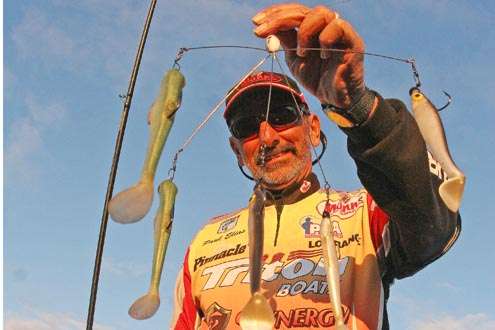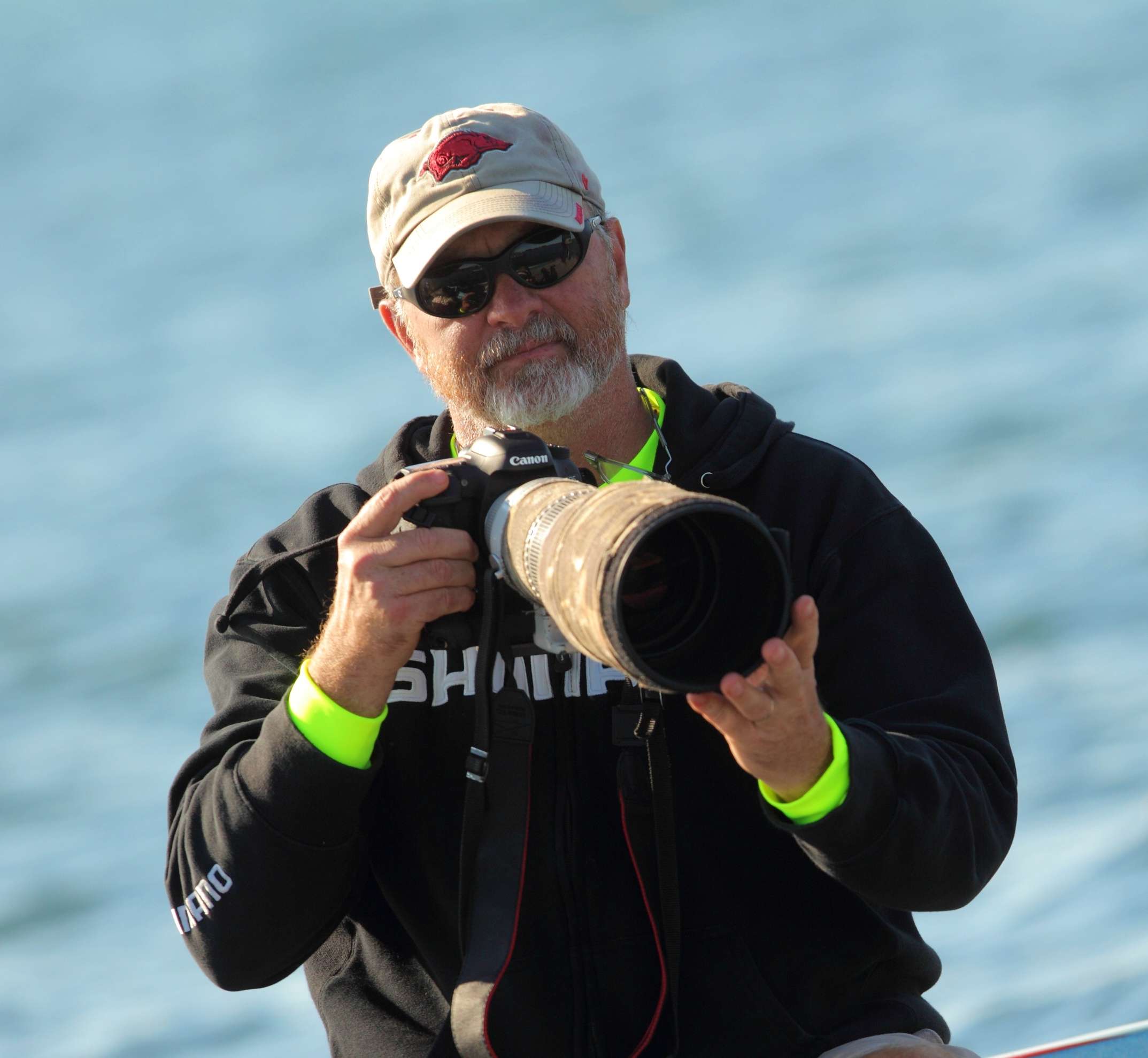
GROVE, Okla. — The Alabama rig craze shows no signs of slowing down. Spend a day on the water with Paul Elias and you could easily see why.
Elias knocked the lid off the Pandora’s Box of multi-hook, castable umbrella rigs a couple weeks ago during an FLW event on Guntersville. It’s a well-known story, obvious by the fact of the craziness that has followed.
“It’s been ridiculous,’’ Elias said as he threw the Alabama rig around Grand Lake in places that the typical angler probably wouldn’t think about tossing it. (More on that later)
Elias said his phone has not ceased from ringing, even during his practice for the BassZone Fish and Chips event it was ring after ring. Some of the calls from friends, some from business partners, some from the manufacturer of the Alabama rig itself, even a call from retired Elite angler Guy Eaker, who was trying to get his hands on a few.
“I’ve heard a lot of crazy stories,’’ Elias said. “They seem to get crazier every day.”
While Elias refused to comment on some of them, the anecdotal evidence of how the Alabama rig is starting to impact the fishing world is such that one can easily believe this isn’t a flash-in-the-pan phenomenon.
“I think it’s for real,’’ Elias said. “This could be a year-round bait.”
It’s definitely one Elias will keep in his arsenal. He almost has to. He has become synonymous with its use around the country.
As an example: While practicing for the Fish and Chips event on Grand Lake, he pulled the Alabama Rig out to throw it around some bridge pilings. He thought he was the only one around when he hooked up with a 5-pound class largemouth, but then he heard someone from behind him comment
“Are you going to whip up on us with that thing again?” came the voice from a boat idling under the bridge. “My dad said if you were in this event, we would be fishing for second place.”
Elias just chuckled. He got a good laugh when he found out later that the voice came from Justin McClelland, Elite angler Mike McClelland’s son, who is always among the local favorites on Grand Lake.
“There’s a little bit of magical feeling about it,’’ Elias said. “It definitely has a lot of people thinking.”
Some are even worrying about it, which is where the craziness comes in. According to a thread on the Bass Fishing Home Page, one of the Alabama rigs sold on eBay for $115. That’s $90 above the retail price of $25.
And it gets worse. Elias has heard of a guide on Guntersville, where he did his initial damage with the rig, who bought 10 for $75 each. He then turned around and put them in a local tackle shop and sold them for $150 each.
They are selling he said because they work, even though they aren’t the silver bullet for every bass swimming in the lake.
In more anecdotal evidence, Elias points to a local tournament on Guntersville the week after his 100-pound stringer. That event was won with a one-day weight of 31 pounds on a frog, which proves fish will still hit the tried and true methods. As for the rig: It was used by the rest of the anglers who were in the top five in the standings of that event.
“That type of thing makes people want it,’’ Elias said.
Right now it’s so hot that expectations, or dare we say rumors, are that there could be as many as 100,000 of them on back order. Those who have them brag of their arsenal; those who don’t covet the opportunity to get one.

Elias says he’s finding more places he can use the Alabama rig.
“People will eventually put it down,’’ Elias said. “But the more I throw it, the more I see all the applications where it can really work.”
He believes the Alabama Rig will be at its strongest in the fall through spring, when fish are schooled up.
“It’s a great cold-water bait,’’ he said. “But it could be a year-round bait.”
Most anglers who look at the rig immediately see where it’s applications around schooling fish would be incredible, since more targets to a feeding frenzy will surely pay off.
Elias, though, looks at the rig as an extension of his fishing in areas where he would normally throw a spinnerbait or a square-billed crankbait.
He has two Alabama rigs on the deck of his boat these days. One is laden with ½-ounce to 3/4-ounce jig heads with swim baits attached. The other has weights in the 3/8-ounce or lighter with swim baits rigged weedless on a 7/0 hook.
The heavy one is slowed rolled around bridge pilings and other deep-water structure. The lighter one, though, shows the potential of the rig. He fishes it in the same place he would throw a spinnerbait or shallow-running crankbait.
During practice on Grand Lake, isolated logs in 2 feet of water were prime targets for running the school of baits over the top.
“They can’t stand it,’’ Elias said. “If they are feeding, they’ll hit a spinnerbait. If you hit the right spot, they’ll hit a crankbait. But a bass on a log can’t resist a school of these baits coming over it.”
To prove his point, the first isolated log during practice served up a 2-pound keeper.
He also has taken to fishing the rigs on rip-rap walls or shallow banks, “it feels just like a crankbait bouncing its way across the bottom.” But he can also fish it around floating docks and cover where fish are apt to suspend around.
He’s learning more about the bait each day he’s fishing it. A couple of good tips:
- The most important as described above is to fish the bait in the same areas as you would a spinnerbait or crankbait. Don’t hesitate to throw it shallow and short casts can work as well as long ones.
- Don’t think of the bait as something where you are going to catch multiple fish. You can, Elias said. But it’s affective at targeting single bites that might not chase a smaller spinnerbait or crankbait.
He does say that multiples can be caught. He caught several on Guntersville. But each time, he already had his weight for the day and those fish didn’t help. He learned, though, that when the first fish hit, if he would set the hook and just hold it in place for a second, then another would hit.
“But when you get a big fish on, you want to move on it,’’ Elias said. “I didn’t play with getting those in the boat. The bigger fish are the ones that will fight against each other and pull off.”
- The last is to pay attention to the depth of the bait and where the fish are holding. Knowing how to get your bait to the right depth is key.
“When I was at Guntersville, I would cast out and then count the bait down until it hit the bottom,’’ Elias said. “If it hit the bottom on a count of 10, on the next cast I would count to 9 and then start reeling.
“By knowing the rate of fall and the depth it needs to be in you can count it down to wherever the fish are.”
At that point, get ready for a little craziness of your own.
“I can promise you the most violent fish strikes you have ever felt,’’ Elias said. “It’s like they have to attack the school, get in and get out.”





